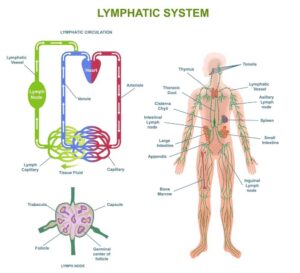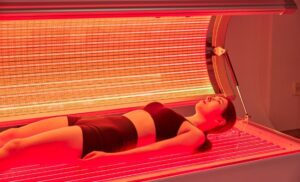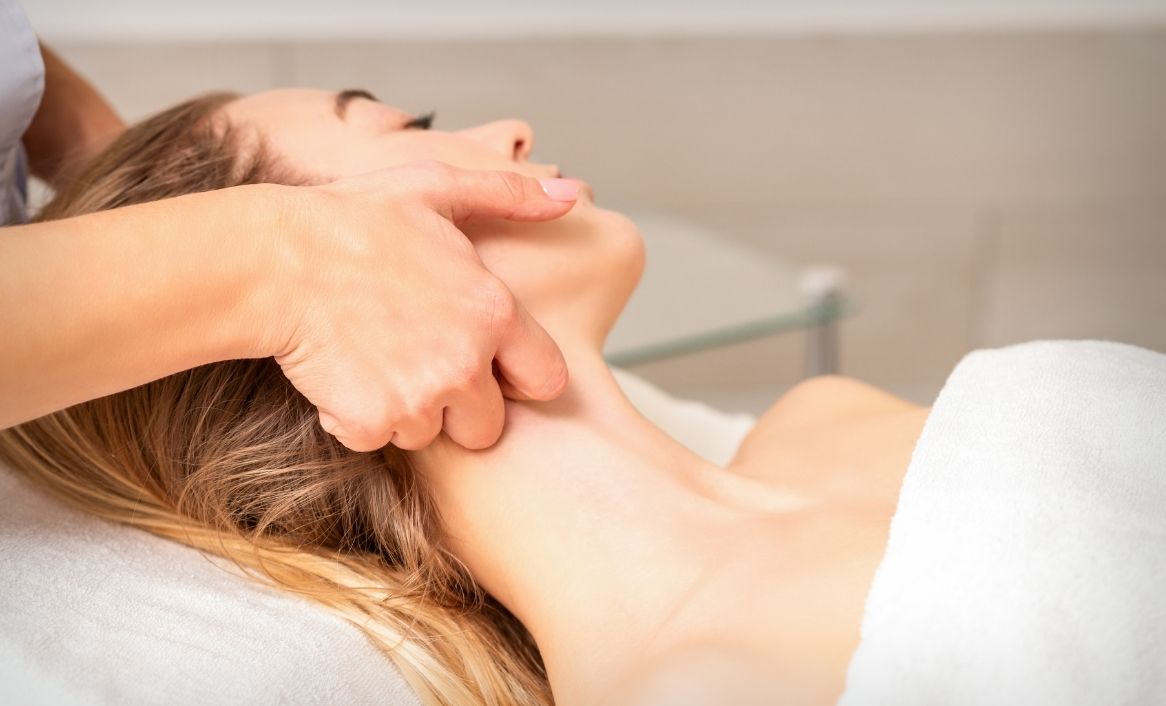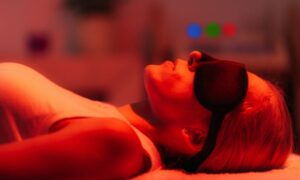The lymphatic system plays a crucial but often overlooked role in our overall health. Acting as the body’s internal “drainage network,” it removes toxins, waste, and excess fluids from tissues while supporting immune defense. However, modern lifestyles characterized by inactivity, poor diet, and chronic stress can slow lymph flow, leading to fluid retention, fatigue, and inflammation.
Red light therapy, also known as low-level light therapy (LLLT) or photobiomodulation (PBM), has emerged as a safe, science-backed solution to support lymphatic drainage naturally. By delivering gentle wavelengths of red and near-infrared light into the skin, this therapy stimulates circulation, cellular repair, and lymphatic movement, helping the body cleanse and rebalance itself.
In this article, we’ll explore how red light therapy for lymphatic drainage works, review the science behind it, and discuss practical ways to integrate it into your overall health routine.
What Is the Lymphatic System and Why Does It Matter?

The lymphatic system is a vital component of the body’s immune and circulatory network. It consists of lymph vessels, lymph nodes, and lymph fluid, which work together to transport waste, toxins, and immune cells.
Main Functions of the Lymphatic System
- Fluid balance: Returns excess fluid from tissues back to the bloodstream.
- Detoxification: Filters waste products and metabolic toxins through the lymph nodes.
- Immunity: Carries immune cells that detect and destroy pathogens.
When lymphatic circulation slows down, it can lead to:
- Swelling or puffiness
- Fatigue and sluggishness
- Weakened immunity
- Inflammation and discomfort
Supporting healthy lymph flow is therefore essential for detoxification, energy balance, and overall well-being.
How Red Light Therapy Works and Supports Lymphatic Drainage
Red light therapy uses wavelengths typically between 630 nm and 850 nm, which penetrate the skin and underlying tissues to reach the lymphatic capillaries and blood vessels beneath the surface. The connection between red light therapy and the lymphatic system lies in the way light interacts with tissues at a cellular and vascular level. Several mechanisms explain how this therapy can support lymphatic drainage and detoxification.
1. Increases Cellular Energy (ATP Production) and Improves Detoxification
Red and near-infrared light stimulate the mitochondria, the “powerhouses” of your cells, to produce more adenosine triphosphate (ATP). This extra energy helps lymphatic vessels contract more efficiently, improving lymph flow and fluid clearance. By boosting mitochondrial function, red light therapy enhances ATP production. Cells with higher energy levels can perform their functions more efficiently, including the removal of waste products and excess fluids. This cellular optimization supports faster recovery, reduced swelling, and improved tissue tone.
2. Enhances Microcirculation and Vasodilation
One of the most well-documented effects of red and near-infrared light is vasodilation, the widening of blood vessels. This occurs due to the release of nitric oxide (NO), a powerful molecule that improves blood flow and nutrient exchange. Improved circulation facilitates lymph movement, helping the body eliminate toxins and reduce fluid buildup. Better oxygen and nutrient delivery to tissues helps reduce inflammation and supports the natural detoxification process.
3. Reduces Inflammation and Swelling
Chronic inflammation can block lymphatic vessels and impair drainage. Red light therapy has been shown to downregulate pro-inflammatory cytokines like IL-6 and TNF-α while boosting anti-inflammatory molecules. This balance reduces tissue swelling and promotes faster recovery. By modulating immune activity, RLT allows lymphatic channels to function more effectively. In clinical settings, patients often report a noticeable decrease in swelling and tenderness after repeated sessions.
4. Stimulates Lymphatic Vessel Activity and Fluid Movement
Animal studies have demonstrated that low-level laser and infrared therapies can increase the contractile activity of lymphatic vessels, effectively “pumping” lymph through the system more efficiently. This mechanical stimulation is crucial for individuals suffering from lymphedema or post-operative swelling. The increased vessel activity leads to better lymph transport, reduced stagnation, and enhanced natural detoxification.
5. Softens Tissue and Prevents Fibrosis
By improving microvascular flow and stimulating collagen remodeling, red light therapy prevents the hardening or fibrosis that can occur from chronic fluid buildup. This is especially beneficial for people dealing with persistent swelling, lymphedema, or post-surgical recovery, as it helps maintain healthy tissue texture and flexibility.
6. Supports Immune Response and Lymph Node Function
Red light therapy enhances immune cell activity within the lymph nodes, improving the body’s ability to detect and fight off pathogens. A well-functioning lymphatic system strengthens immune defense and overall resilience.
7. Supports the Glymphatic System (Brain Detox)
Recent studies suggest that near-infrared light may enhance the glymphatic system, the brain’s waste clearance mechanism. By improving cerebrospinal fluid flow, light therapy may help eliminate metabolic waste from the brain, a process closely related to overall lymphatic health and detoxification.
Scientific Evidence on Red Light Therapy and Lymphatic Function
Multiple studies have investigated the impact of red and infrared light therapy on lymphatic function, particularly in cases of lymphedema and post-surgical edema.
-
Breast Cancer–Related Lymphedema (BCRL):
Several randomized controlled trials have demonstrated that red light therapy (RLT) can reduce limb circumference, alleviate pain, and improve tissue elasticity in patients with BCRL. For instance, a study published in Photomedicine and Laser Surgery found that RLT significantly decreased arm volume and improved quality of life in breast cancer survivors with lymphedema.
-
Post-Surgical Recovery:
Clinical studies indicate that RLT accelerates healing, reduces bruising, and diminishes swelling following surgery. A review in Photomedicine and Laser Surgery highlighted RLT’s effectiveness in managing postoperative edema and promoting tissue repair.
-
Head and Neck Lymphedema:
Patients undergoing radiation therapy for head and neck cancer have reported improvements in range of motion, reduced fibrosis, and enhanced comfort after receiving RLT. A pilot study published in Supportive Care in Cancer noted positive patient experiences, including decreased swelling and increased saliva production.
-
Animal Studies:
Experiments on rodents have shown that exposure to near-infrared light can enhance lymphatic drainage, increase vessel permeability, and speed up the removal of interstitial fluid.
While further research is needed, the existing evidence strongly supports the safety and efficacy of red light therapy as a supportive treatment for lymphatic conditions.
Benefits of Red Light Therapy for Lymphatic Drainage
1. Enhanced Detoxification
Red light therapy stimulates lymph movement, helping the body flush out toxins and waste products more efficiently. This process supports organs like the liver and kidneys, which handle detoxification. Many people report feeling “lighter” or more energized after consistent sessions due to improved internal cleansing.
2. Reduced Swelling and Inflammation
Inflammatory conditions, injuries, or surgery can cause fluid buildup (edema). Red light helps minimize swelling by promoting microcirculation and reducing inflammatory molecules such as prostaglandins and cytokines. This makes it especially useful for post-surgery recovery or chronic inflammation.
3. Improved Immunity
A properly functioning lymphatic system enhances immune defense. By energizing immune cells and improving lymph transport, red light therapy can help your body detect and respond to infections faster.
4. Faster Recovery from Lymphedema or Edema
Clinical research shows that low-level laser therapy can reduce limb circumference and pain in individuals with lymphedema, particularly after breast cancer surgery. It softens fibrotic tissue and encourages the regeneration of damaged lymph vessels.
5. Better Skin Health
Skin conditions like acne, puffiness, and cellulite often have links to poor lymphatic drainage. RLT helps clear stagnation, improve circulation, and promote collagen production, leading to smoother, firmer, and healthier-looking skin.
Best Practices: How to Use Red Light Therapy for Lymphatic Drainage
1. Device Selection
Choose high-quality LED panels or handheld red light therapy devices that emit wavelengths between 630 nm and 850 nm.
Full-body panels or targeted devices are both effective depending on your needs.
2. Treatment Duration
- Per session: 10–20 minutes
- Frequency: 3–5 times per week for best results
- Maintenance: 2–3 times weekly after initial improvement
3. Target Areas
Focus on regions with high lymph node concentration:
- Neck and under the chin (cervical lymph nodes)
- Underarms (axillary nodes)
- Groin and thighs (inguinal nodes)
- Abdomen and lower legs
4. Combine with Natural Methods
Red light therapy works best when combined with:
- Hydration: Helps flush toxins efficiently
- Dry brushing or massage: Stimulates lymph flow manually
- Exercise: Boosts circulation and muscular lymph pumping
- Deep breathing: Enhances thoracic lymph drainage
5. Duration of Results
Most users notice improvements such as reduced puffiness, lighter legs, and better energy within 2–4 weeks of consistent use.
Safety and Side Effects Of Red Light Therapy For the Lymphatic Drainage System
Red light therapy is widely regarded as safe and non-invasive, with minimal to no side effects when used properly.
Common Mild Reactions
- Temporary warmth or redness at the treated site
- Mild fatigue due to detox activation
- Light sensitivity (rare)
Avoid Use If:
- You have active cancerous lesions or are undergoing radiation therapy without medical approval
- You suffer from photosensitive disorders or use medications that increase light sensitivity
- You have open wounds or active infections in the target area
When used correctly, red light therapy is one of the most gentle yet powerful methods to support lymphatic and overall wellness.
Who Can Benefit from Red Light Therapy for Lymphatic Drainage
Red light therapy is suitable for a wide range of users, including:
- Individuals with poor circulation or fluid retention
- Those experiencing post-workout swelling or soreness
- People looking for non-invasive detox support
- Wellness and spa enthusiasts seeking natural rejuvenation
- Those recovering from mild surgeries or cosmetic procedures
It’s particularly beneficial for sedentary individuals or those exposed to chronic inflammation and stress, both of which impair lymph flow.
Combining Red Light Therapy with Other Lymphatic Drainage Techniques
Manual Lymphatic Drainage (MLD)
Red light therapy can be paired with manual lymphatic drainage (MLD), a gentle massage technique that stimulates lymph flow. While MLD manually moves lymph fluid through the body, combining it with RLT can enhance the benefits by reducing inflammation and promoting circulation more effectively.
Compression Therapy
Compression garments are commonly used to reduce swelling and improve lymphatic flow. When combined with red light therapy, they can be especially beneficial for individuals with lymphedema or chronic fluid retention, as RLT further supports vessel activity and decreases inflammation.
Hydration and Movement
Maintaining proper hydration and engaging in regular physical activity, such as walking or stretching, naturally supports lymphatic function. Red light therapy complements these lifestyle practices by improving circulation, enhancing tissue repair, and further promoting efficient lymphatic drainage.
Red Light Therapy vs. Manual Lymphatic Drainage (MLD)
Manual Lymphatic Drainage (MLD) is a specialized massage technique that manually stimulates lymph flow. It uses gentle, rhythmic strokes to encourage fluid movement toward lymph nodes.
While MLD is highly effective, it can be time-consuming and must often be performed by trained therapists. Red light therapy, on the other hand, offers a hands-free, non-invasive alternative that can be performed at home.
The best results often come from combining both methods:
- MLD provides immediate mechanical stimulation.
- Red light therapy enhances microcirculation and vessel activity at the cellular level.
When used together, they synergistically boost lymphatic drainage, tissue healing, and detoxification.
Choosing the Best Red Light Therapy Device for Lymphatic Drainage
When selecting a device, focus on the following features rather than specific brands:
- Dual wavelengths (630–660 nm + 800–850 nm)
- Sufficient irradiance (≥30 mW/cm²) for deeper penetration
- Even light distribution across the treatment area
- Large coverage area for limbs or torso
- FDA-cleared or clinically validated design for safety assurance
Professional-grade systems often yield faster results, but high-quality home devices can be equally beneficial when used consistently.
Enhance Your Lymphatic Health with Hue Light Photobiomodulation Devices

Photobiomodulation (PBM) devices are designed to deliver optimal red and near-infrared wavelengths (630–850 nm) to support lymphatic drainage, circulation, and cellular repair. Using clinically studied light therapy technology, these products help stimulate lymphatic vessel activity, reduce swelling, and promote tissue recovery.
Whether used at home or in professional wellness settings, these devices provide a safe, non-invasive way to complement your detox routines and improve overall wellness. The ergonomic design and adjustable settings allow you to target specific areas like arms, legs, neck, or torso, ensuring effective lymphatic support and energy restoration.
Key Benefits of Hue Light PBM Devices:
- Promotes lymphatic flow and natural detoxification
- Reduces inflammation and swelling
- Supports immune function and cellular repair
- Easy-to-use, safe, and non-invasive
- Ideal for home wellness routines or professional therapy sessions
By integrating PBM devices into your regular wellness practices, you can enhance the effects of red light therapy on lymphatic drainage, recovery, and overall health.
Conclusion: Enhancing Lymphatic Health Naturally
The lymphatic system is central to your body’s detox, immune, and circulatory balance, yet it often receives far less attention than it deserves. Red light therapy offers a scientifically supported, non-invasive, and accessible way to keep this vital system functioning optimally.
By stimulating lymphatic flow, improving circulation, and supporting detoxification, red light therapy not only helps reduce swelling and puffiness but also promotes deeper energy, skin glow, and resilience.
Whether used as a home wellness tool or alongside other detox methods like hydration, exercise, and massage, consistent use can lead to lasting benefits for both physical and mental well-being.
Ready to boost your lymphatic health and overall wellness? Experience the benefits of Hue Light photobiomodulation devices today. Try it at home and enjoy reduced swelling, improved circulation, and enhanced energy.













